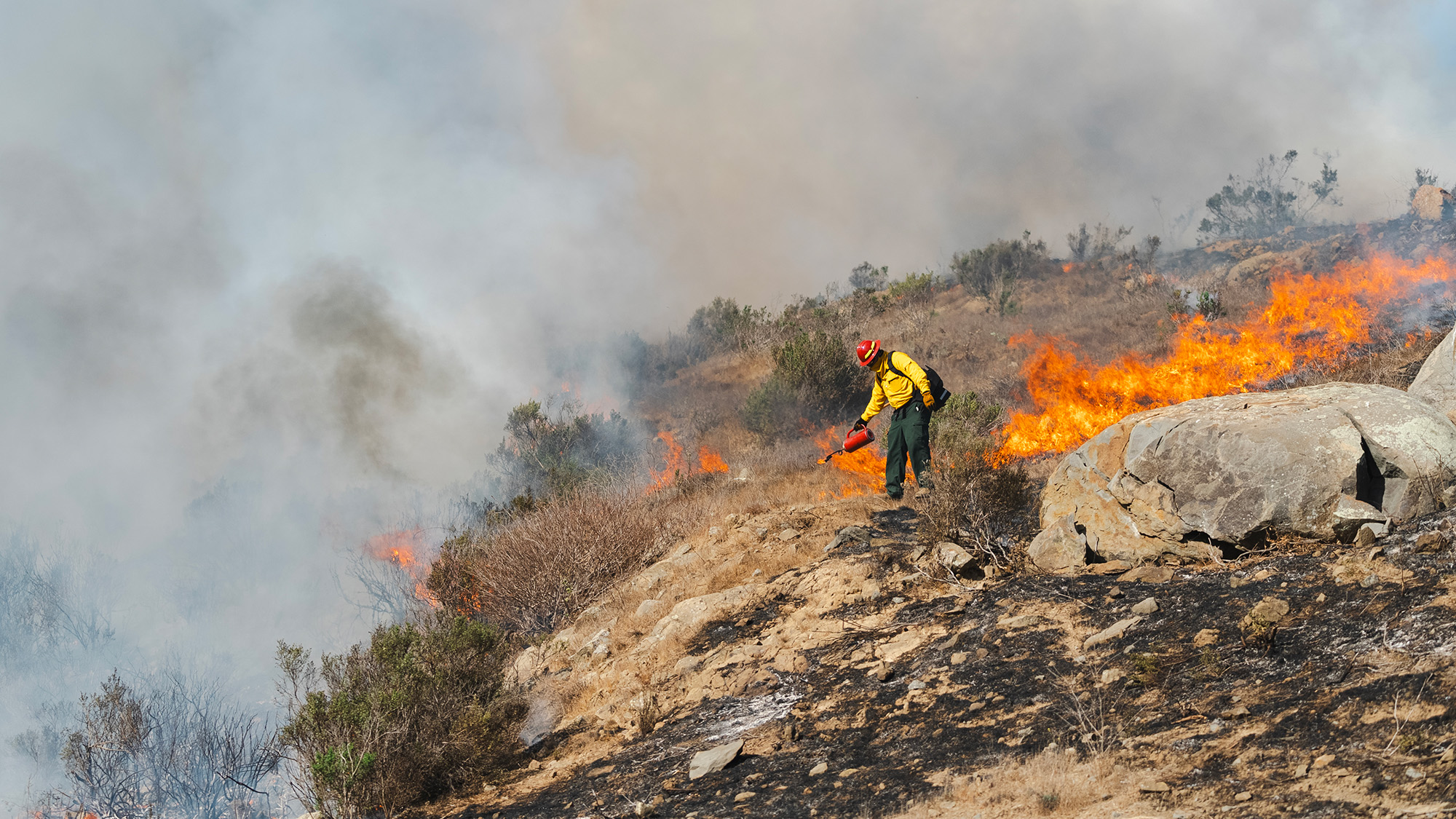FROM ASHES TO ACTION: Cal Poly's FAVE Program and the Fight Against Wildfires

By: Brian Fischer
A dangerous cycle has engulfed our planet. Excessive wildfires produce greenhouse gases that help accelerate climate change, which creates hotter and drier conditions that fuel more fires.
These effects can be seen in Cal Poly’s home state, as the 10 largest California wildfires have all happened within the past 20 years, with six in the last three years. In 2023, over 7,000 wildfires burned nearly 325,000 acres across the Golden State.
Cal Poly felt the effects of wildfires firsthand when the CZU Lightning Complex fires swept through Swanton Pacific Ranch in Santa Cruz County. The ranch, gifted to the university in 1992, offers students a hands-on, one-of-a-kind experience in a remote environment outside of the main campus in San Luis Obispo. While no people or ranch animals were harmed, the fire destroyed many of the ranch’s structures, including all the staff and student housing.
Out of the ashes, Cal Poly’s Fuels and Vegetation Education (FAVE) program was born. Funded by CAL FIRE and the Healthy Forest Initiative, FAVE is a workforce development training program designed to increase the pace and scale of fuels treatments to make California more resilient to wildfire. Featuring webinars and field-based workshops in every corner of California, FAVE aims to increase training and research on the application of prescribed fire as a land management tool for vegetation management and wildfire resilience. Essentially, fighting fire with fire.
"A prescribed burn is when professionals carefully plan to burn a broad swath of vegetation, taking into account weather, air quality, fuels and conservation objectives," explains Grey Hayes, former FAVE program director.
"They are implemented to reduce the severity, rate of spread, and impacts of more severe wildfire, restore habitat, and/or to train firefighters so that they can better predict fire behavior," says Hayes.
As this field continues to grow, so does the need to train more fire practitioners. Over the two years the FAVE program has been running, over 1,700 people have attended the 25 webinars, while over 400 have attended the 14 on-site field trainings, with attendance steadily rising. FAVE’s popularity has grown thanks to word of mouth in the fire and land management community.
Gavin Albertoli, project manager for Marin County Fire Department’s Vegetation and Fuels Management Program, has been attending FAVE trainings from the first offerings. "The FAVE program and trainings have provided invaluable training and exposure to topics and lessons that I use in my work regularly and has provided many great project examples to learn from. Additionally, the program has introduced me to many great people in the industry and has allowed me to expand my professional network."
While many might see wildfires as synonymous with California, they are not isolated to our location. Devastating fires in Canada, Texas, Hawaii, Australia and Greece have all made recent headlines. Each year wildfires increase in frequency, intensity, and locations, even stretching into areas across the globe that have historically been too cold to experience notable fires. There is no denying that wildfire fuel mitigation is now a global issue.
The Prescribed Fire Training Exchanges (TREX) events were created to build capacity and expertise in using fire as a tool for land management and ecosystem restoration. Since its inception in 2008 in the Great Plains, TREX events have expanded significantly. In 2023, over 140 TREX events were held in the United States, including the inaugural Santa Barbara TREX event. This past year events were held in both San Luis Obispo County and Santa Barbara County, welcoming fire partners from Cal Fire, Sequoia Riverlands Trust, California State Parks, Cal Poly and more.
The second annual TREX in Santa Barbara brought together fire practitioners and future firelighters from around the globe to "learn and burn." The FAVE program was invited to participate in this eight-day, intensive, experiential learning environment, sharing information on planning, operations, equipment, certifications and safety to build capacity for community-based burning programs.
Monica Matthews, a conservation ecologist at the Ventura County Resource Conservation District, saw the benefits of attending the exchange. "SB TREX got me trained considerably and the Purisima Ridge field tour was another great example of ecologically sound fire mitigation; both great professional opportunities."
Gavin Albertoli had a similar experience. "My favorite part of the SB TREX program was the opportunity to meet, learn from, and interact with such a great and experienced leadership team," says Albertoli.
Additionally, the community building aspect of TREX was equally as memorable for Matthews, as she recalled "standing around a small bonfire, enjoying the company of people from all over the Americas and even Europe."
The key focus of TREX is to promote cooperative burning practices, help diverse partners leverage skills, resources, and staff in ways that maximize opportunities for relationship and skill building, resource sharing and collaboration. It also builds capacity for community-based burning by promoting the ecological health of diverse Santa Barbara landscapes while meeting cultural training and wildfire mitigation goals.
Recently TREX was able to offer an Indigenous Stipend Scholarship Program, designed to help remove barriers to attending by making the tuition, training, and travel costs more accessible to Tribal members who wanted to attend this training exchange.
"I hope that FAVE can continue to bring together and educate professionals on the rapidly evolving vegetation management and fuels treatment tactics that Californians will depend on given the anticipated increasing fire frequency and intensity due to climate change," says Hayes.
"The governor has set a bar of performing prescribed fire on 500,000 acres per year; currently, we burn less than 10% of this."
"Prescribed fire is the only way to make enough areas safe from the catastrophic, large-scale wildfires of California’s future. To do this, we will have to greatly increase the number of professionals working in this arena. Those people need training, networking, and mentorship… which is what FAVE is facilitating," says Hayes.

 | EPaCE
| EPaCE